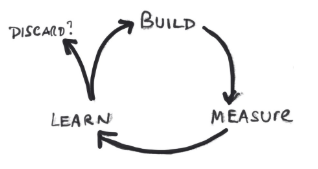- What does it mean to be data driven ?
- “Being data driven is not a matter of data…”
It’s not because someone is collecting huge amounts of data or is continuously looking into their dashboards or any other tools that he or she is data driven. The volume of data you are gathering and the way you follow-up on their evolution are only starting points in the path for being or becoming truly data driven.
- What does it take to be(come) data driven ?
Being data driven is a vision companies want to achieve. Reaching this objective requires three crucial elements. First, the mindset and the culture that is developed within the company. Second, the model that is applied in the day to day tasks. Third, the execution process which is the connector between culture and model, between theory and practice. In short - operations. It describes how stakeholders will set the model in music in the unique context of their project based on the common culture they share. The execution process encompasses the interactions between stakeholders and the way decisions are made within the scope of the project.
Being data driven is a challenge for everyday’s project. From making a successful media campaign to launching a new website or even running a business. Being data driven is not a project, it’s a philosophy.
1. The Culture
A culture is made of values. To be data-driven, most important values are the following:
Be flexible: which means have the freedom and the capacity to adapt along the road based on what you observe and the feedback (data) you gather. Indeed, business environments aren’t rigid, competition is moving fast, clients’ needs are evolving and so the need to adapt by integrating the latest informations.
Be open: in the sense of being curious to always go deeper in the project and continuously looking for excellence. Aside of being curious, being open also mean accepting criticism and negative returns that will help move forward.
Share: running projects often requires the involvement of several stakeholders. Sometimes from different departments or even companies (partners). A good communication is crucial to make sure everyone is moving forward in the same direction and share the information he has access to.
Culture is also a matter of the empowerment of internal resources, in terms of people. This being done, among others, through the tools that are used to gather the data that feeds decisions process.
2. The Model
The model that articulates a data driven mindset is called ‘test & learn’. Indeed, it gives you the opportunity to continuously build during the run of your project through the flexibility you develop. Nothing is cast in stone and everything is flexible. A test & learn model implies three mains phases

- Building phase: during which you first define your goals or the hypothesis you would like to test. Secondly, you define the strategy you will use to achieve your goals or test your hypothesis. Finally, you set this up and put your project in motion.
- Measuring phase: during which you monitor the advancement and performance of your project by collecting data (in all possible ways) through the tools you have at your disposal.
- Learning phase: which consists in the analyses of the data you have collected in the measurement phase. You gather all the insights and learnings about what is going well and what is not.
Based on those learnings you can then iterate this circle, re-entering the building phase with the idea of optimizing what is not performing as expected and moving deeper into what is going well. The beauty is, you don’t have to wait for the project to be over in order to reiterate. All steps can be performed while the project is live, so learnings can immediately have an impact.
This ‘test & learn’ model is often compared to the commonly used ‘build build build’ model:

To illustrate those two models, let’s take the example of a person willing to launch a new website. With both models, the first step for will be to define the goal(s) (s)he is trying to achieve with this new website. This implies making a plan of how the future website will look like (layout, features, etc.). The big difference happen when the project enters the running phase:
With the ‘build build build’ model the website will only be launched once all the elements that were defined in the initial plan have been successfully integrated before being launched on the market.
On the other hand with the ‘test & learn’ model, a first version of the website will be released as soon as a minimum viable product (MVP) is ready to be tested. This will ensure the collection of feedback (data) from potential customers that will serve for the adaptation of the initial plan. The MVP refers to a development technique in which a new product is first released in its most pared down version. This version is meant for early adopters. The final product with full set of features is only developed after integrating the feedback of those early adopters. This process of building - measuring - learning is then continuously iterated.
We can illustrate the outputs of both models with the following:

The output of the ‘build build build’ model is on the right on the above graph. Point A is where we stand when we know we want to launch and new website and we’ve defined our plan (layout, features, etc.) of what it will include. Point B is the release of the website that took 3 months to be built.
The output of the ‘test & learn’ model is on the left on the above graph. Point A and B have the exact same significations as described in the previous section. Point (1) represents the evolution of the project after a month, the release of the first minimum viable product. Point (2) and (3) are the evolution of the product after 2 and 3 months. Thanks to the flexibility and the ability to build on the run, the final website of the ‘test & learn’ model (point (3)) outperforms the website we have built with the ‘build build build’ model (point B).
When running a project, whatever its scope, most project managers define long term plan to plan where they would like to be in the future. Having a long term vision is very important to give the direction. Nevertheless, the environment we live in is in perpetual motion. It requires innovation to create new ways of working. It requires questioning to continuously challenge the visions. Finally, it requires flexibility to adapt quickly if those visions are not aligned with the market’s expectations.



